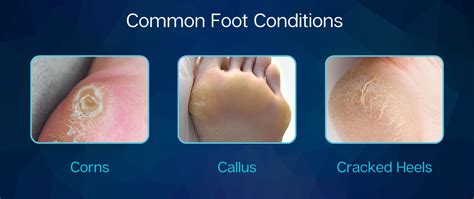A callus on the foot can be a painful and frustrating issue, affecting not only the comfort of our daily lives but also our overall well-being. These thickened areas of skin, also known as hyperkeratosis, are the body’s natural response to repeated pressure, friction, or other forms of irritation. Understanding the causes, symptoms, and treatments of calluses on the foot is essential for managing and preventing them.
Causes of Calluses on the Feet
Calluses on the feet are most commonly caused by repetitive friction or pressure. This can come from a variety of sources, including poorly fitting shoes, abnormal gait patterns, or participating in activities that place persistent stress on specific areas of the foot. For instance, runners might develop calluses on the balls of their feet or the heels due to constant impact and friction, while people with jobs that require standing for long periods might notice calluses forming under the heels or the balls of the feet.
Symptoms of Calluses
The symptoms of calluses are relatively straightforward and usually include:
- Thickening of the skin: The most noticeable sign is the thick, hardened layer of skin.
- Discoloration: Callused areas may appear lighter or darker than the surrounding skin.
- Pain or discomfort: Especially when pressure is applied directly to the callus.
- Rough texture: Calluses can feel rough to the touch.
Treatment Options for Foot Calluses
Fortunately, there are several treatment options available for foot calluses, ranging from home remedies to professional interventions.
Home Remedies
- Pumice stone or foot file: Gently removing dead skin cells can help reduce the size of the callus.
- Moisturizing: Keeping the foot well-moisturized can help soften the callus, making it easier to remove.
- Padding and orthotics: Applying pads or using custom orthotics can redistribute pressure and reduce friction.
Professional Treatments
- Debridement: A healthcare professional can carefully remove the thickened skin, which can provide temporary relief.
- Prescription orthotics: Custom-made inserts can address underlying issues such as uneven gait or foot shape.
- Surgery: In severe cases where calluses are caused by underlying deformities, surgery might be an option.
Prevention Strategies
Preventing calluses from forming in the first place is the most effective management strategy. Here are a few key preventive measures:
- Wear properly fitting shoes: Ensuring that shoes are not too tight or too loose can help reduce friction and pressure.
- Usepadding and orthotics: Adding extra cushioning or support inside shoes can alleviate pressure points.
- Maintain good foot hygiene: Regularly washing and moisturizing the feet can prevent dryness and cracking, which can sometimes lead to callus formation.
Complications and Risks
While calluses themselves are generally not a serious health concern, they can sometimes lead to more significant issues, especially in individuals with certain health conditions. For example, people with diabetes are at a higher risk of complications from untreated calluses due to potential nerve damage (neuropathy) and poor wound healing. It’s essential to monitor any changes in the skin and seek medical attention if a callus becomes inflamed, bleeds, or shows signs of infection.
Practical Tips for Managing Calluses
For those dealing with calluses, here are some practical tips to keep in mind:
Step 1: Assess Your Footwear
Evaluate your shoes for proper fit and consider visiting a shoe fitter if necessary.
Step 2: Apply Regular Moisturizer
Keeping your feet moisturized can help prevent dry skin, which might contribute to callus formation.
Step 3: Use Foot Care Tools
Gently remove dead skin cells with a pumice stone or foot file, but avoid overdoing it to prevent further irritation.
Advanced Insights into Callus Formation
Recent studies have highlighted the importance of biomechanical factors in the development of foot calluses. Understanding how gait patterns, foot anatomy, and shoe design interact can provide valuable insights into prevention and treatment strategies. For instance, custom orthotics designed to address specific biomechanical issues can be highly effective in reducing pressure points and preventing callus formation.
Conclusion
Calluses on the foot are a common issue that can be both a nuisance and a source of pain. By understanding their causes, implementing preventive strategies, and seeking appropriate treatment when necessary, individuals can effectively manage calluses and maintain healthy, comfortable feet. Whether through home remedies, professional interventions, or a combination of both, there are numerous paths to relief and prevention.
What are the most common causes of calluses on the feet?
+The most common causes include poorly fitting shoes, abnormal gait patterns, and activities that place repeated stress on specific areas of the foot.
How can I prevent calluses from forming on my feet?
+Prevention strategies include wearing properly fitting shoes, using padding and orthotics, and maintaining good foot hygiene through regular washing and moisturizing.
What are the potential complications of untreated calluses, especially in individuals with diabetes?
+Untreated calluses can lead to inflammation, bleeding, or infection. In individuals with diabetes, there’s a higher risk due to neuropathy and poor wound healing, making regular monitoring and professional care crucial.



